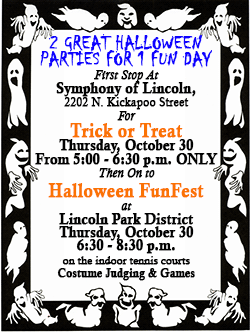|
 Chairperson of the LHPC April Doolin started off the session by
saying that the reason for the class was not only to present the
resources that are available locally to do home research, but to
foster pride in the community. Doolin mentioned that while the
downtown Lincoln Historic District is in place, the LHPC wants to
offer the opportunity for home owners to register their homes in a
historic district that will insure that landmark houses are
protected and preserved. A home that is in a designated historic
district can take advantage of state programs that can help with
preservation. “This is a way to preserve the history of Lincoln,”
said Doolin. Chairperson of the LHPC April Doolin started off the session by
saying that the reason for the class was not only to present the
resources that are available locally to do home research, but to
foster pride in the community. Doolin mentioned that while the
downtown Lincoln Historic District is in place, the LHPC wants to
offer the opportunity for home owners to register their homes in a
historic district that will insure that landmark houses are
protected and preserved. A home that is in a designated historic
district can take advantage of state programs that can help with
preservation. “This is a way to preserve the history of Lincoln,”
said Doolin.
Richard Sumrall had a checklist for the group of ten in attendance,
a list of the rich resources that are available for research at the
library. The number one resource is the library staff that is
extremely knowledgeable about what is available and how to access
it.


Sumrall mentioned the 2000-2001 Lincoln High School Architectural
History Project. Each student participating in the survey of
historic Lincoln homes was assigned one house to research. All of
the results were compiled into a book that is available for research
purposes at the library. Sumrall was very generous in his praise for
the quality of the book, and its usefulness as a tool for the home
researcher.
“One of the most important resources for home researchers is a city
directory,” said Richard Sumrall. The library has directories from
1875 on. These books are packed with relevant information and are
indexed by name and address.

The library also has census microfilm which is provided by the
federal government. It lists names and family members at a given
address. Want to know who preceded you in your house? Here is a
source for this information. The library’s census data starts in
1830.
While the library has copies of the Lincoln Courier and its
predecessor from 1859 to present, it requires knowledge of a
specific date to access data. During the Civil War years, this
resource is a bit thin; but records from the 1870’s on are very
good. The newspaper could be useful if an article was written about
a home modification or even the construction of a significant
building.
The library has city and county atlas from several years that show
lots in the various Logan County towns. It was noted by several
members of the class that their current lot size does not match the
original shown in the atlas. Sumrall noted that neighbors could buy
and sell small pieces of their holdings thus changing the original
shape of a block. House numbers have even changed over the years.
All of this sometimes makes the search for records somewhat more
complex. A baseline is the atlas which would list the original lot
size.

One treasure that is available at the Lincoln Public Library that
Sumrall is particularly proud of is a trove of original blueprints
of some Lincoln homes. The preeminent architectural firm in Lincoln
in the early 20th century was Deal and Ginzel, designer of the
current Logan County Courthouse and many other buildings in central
Illinois. All of the firm’s records were purchased by a Springfield
architectural firm and are now available at the library. While some
of these blueprints are in fragile condition, Prairie Engineers has
the necessary equipment to photocopy them. Sumrall praised the firm
for making their equipment available to the library.
Several history books about Lincoln and Logan County by renowned
local historians such as Lawrence Stringer, Paul Gleason, and Paul
Beaver are in the library stacks. These have proved useful in
separating fact from fiction where houses are concerned.
[to top of second column] |

“The library staff and resources are available during regular library hours, but
if a question occurs to you outside of these hours, just go to the Lincoln
Public Library website and click on ‘Ask a Librarian’, and we will get back to
you as soon as possible,” said Sumrall.
_small.JPG)
Richard Sumrall
and Diane Osborn Diane Osborn is searching Lincoln
block-by-block for historic homes, and is well versed in the
research sources that are available locally and how to use them. She
recommends the Logan County Genealogical & Historical Society
research facility on Chicago Street and the volunteers who staff the
facility. They are very well versed in the extensive records and are
always willing to help the home researcher. While some of the LCGHS
records may overlap those of the library, Osborn has found some city
directories that the Society has that are not in the library. “Using
both resources together is essential to finding as much information
as possible,” said Osborn.
The LCGHS has a collection of abstracts that have been donated over
the years that are carefully stored in a vault. A home researcher
may find just the one for their current research effort. Also
available is central Illinois historian and artist David Alan
Badger’s book of illustrations of historic Lincoln homes.
One simple tool to determine a home’s history is to ask a long time
neighbor of the property. Diane Osborn knocks on doors and asks
questions. “You can do the same,” she said.

Over the years, several Lincoln service clubs have offered holiday
home tours. The programs from these events can be a valuable
research tool.
Osborn recommends county government as another resource for doing
home historical research. The Logan County Assessor, County Clerk,
and Circuit Clerk have many records that can be useful, and office
personnel who can assist. Tanya Conrady in the County Clerk’s office
and Brenda Jones in the Circuit Clerk’s office are research
specialists. The Assessor has tax bills that sometimes show the age
of a house. The County Clerk has land records from 1839 and city
directories. Probate records are available in the Circuit Clerk’s
office, information that is important in determining who inherited
property upon an owner’s death.
One final resource is the Logan County Title Company. Osborn pointed
out that this is a private company, and will do historical research
as time allows. They also charge a fee for copies.
Osborn is happy to discuss historical home research. If you have a
historical home that she has not yet uncovered or if you want some
advice on doing your own home biography, she can be contacted online
at diane.osborn@comcast.net or 217-605-0011. She wants to hear about
your historic home.
What do you really want to know about your 19th century historic
home, or for that matter, just the 1950’s bungalow or ranch that you
bought twenty years ago? Think about it. When was it built and who
designed it, who the first residents were, and who has lived in it
since? Are there any secrets within those familiar walls? Lincoln
has the resources to find the answers to these questions. You just
have to know where to search.
[Curt Fox]
 |